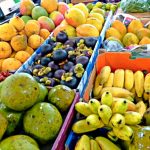Most people have salt in their diet and either add it to their food as table salt or consume it via the processed foods that they eat as in prepackaged meals, for example.
But the evidence tells us that too much sodium can cause you serious health problems and this is what you’ll discover in our video today.
Even though salt has played a large role in the human diet for many thousands of years, science is now revealing more and more that eating salt can have serious implications for your health.
How Much Salt Is Healthy And How Much Is Harmful
The 2015–2020 Dietary Guidelines for Americans recommends that Americans consume less than 2,300 milligrams (mg) of sodium per day. (1)
The American Heart Association says:
“For optimal heart-health, the American Heart Association recommends people aim to eat no more than 1,500 milligrams of sodium per day. That level is associated with a significant reduction in blood pressure, which in turn reduces the risk of heart disease and stroke”. (2)
So to give you an idea:
- 1/2 teaspoon = 1,150 mg sodium
- 3/4 teaspoon = 1,725 mg sodium
- 1 teaspoon = 2,300 mg sodium
Now many people think that if they don’t consume table salt that the other so called ‘natural’ alternatives are much healthier for them to consume such as sea salt, for example.
But according to the AHA this is not the case, certainly when it comes to high blood pressure:
“Myth. I use kosher or sea salt when I cook instead of regular table salt. They are low-sodium alternatives.
Chemically kosher salt and sea salt are the same as table salt – 40 percent sodium – and count the same toward total sodium consumption”. (3)
So don’t think that just because you use so called natural salt that it is any different to table salt – at least when it comes to high blood pressure.
Now, guess how much salt Americans consume on average?
On average, Americans eat more than 3,400 milligrams of sodium each, which is significantly more than both of the recommended daily intakes that we have just talked about.
This raises the average American’s risk of suffering from serious health issues, including both strokes and heart disease.
What is also important to note here is that the human body can adapt and carefully regulate its levels of sodium when it comes to our sodium intake.

If you start consuming significantly less sodium in your diet for example, you can get to a stage where your body will then look to preserve its sodium stores and recycle them, which is done with the aid of the hormone aldosterone.
The consumption of too much sodium can not only increase your risk of high blood pressure (hypertension), stroke and heart disease, but also other health issues that include (4):
- Stomach cancer
- Osteoporosis
- Autoimmune problems
- Edema (water retention)
- Acid reflux
- Migraines
How Salt Affects Your Arteries
There have been studies done that have looked at the impact of sodium consumption on human arterial health, which of course are vital to the proper functioning of our hearts and indeed our entire circulatory system throughout our whole body.
One such study looked at reducing sodium intake by just ½ a teaspoon per day to 6 grams from the usual 9 grams and a significant improvement in artery function was discovered after just 2 days of eating this lower level of sodium. (5)
Another study looked at these people to see if their sodium intake negatively affected their artery function even when their blood pressure did not increase.
They found that indeed their artery function was significantly impaired by their sodium intake independent of their blood pressure and that the harm to their arteries happened within just minutes of them consuming salt. (6)
So How Much Salt?
It’s worth noting that for the large majority of human evolution, we most likely ate the equivalent of one quarter of a teaspoon worth of salt a day, so that works out at about 575 mg of sodium as we ate mostly plants in our diet and were certainly not using salt shakers back then. (7)
On a whole foods plant diet, including an all raw or mostly raw one it is very easy to consume this same level of sodium, myself included.
If you eat plenty of green leafy vegetables and sodium rich foods in your diet, you’ll have no problem with obtaining enough sodium.
I have been consuming a salt free, fruit based vegan diet for over 7 years now and I live in a hot tropical climate.
I like to run and exercise and I’ve never suffered with low sodium levels. I also know many others who eat the same kind of diet that I do and who also don’t need to have salt in their diet either.
Eating a diet where I get my sodium from whole plant foods, I have noticed how my taste buds have become much more sensitive now and because of this I am able to enjoy the more subtle nuances of the foods that I eat and so enjoy my food much, much more.
Yes, some people do like to add a bit of salt to their food even if it is just a pinch and there’s no real evidence to show that very small amounts of salt can harm your health.
But I think the bottom line here is that getting your sodium from whole plant food sources is your healthiest bet.
Sodium rich food sources
Below is just a small list of whole raw foods that contain good amounts of sodium:
- Celery
- Coconut water
- Carrots
- Kale
- Honeydew Melon
- Cantaloupe Melon
- Swiss Chard
- Beets
- Tomatoes
- Lettuce
Getting sodium through eating a whole raw food diet wins hands down because:
- It is more bioavailable, due to chelation (binding) which means it is much easier for the human body to absorb.
- Fruits and vegetables more than easily cover all your bases when it comes to mineral content (as long as the soil it is grown in is healthy/mineral rich).
- Overdosing on sodium and suffering the health consequences from eating a raw food diet that includes fruits, vegetables nuts and seeds is unheard of.
What’s your experience with salt? Do you add any to your diet or do you get it naturally from whole plant foods? Post your comments below!
Sources:
1. https://www.cdc.gov/salt/pdfs/Sodium_Dietary_Guidelines.pdf
4. http://jeffnovick.com/RD/Articles/Entries/2013/10/3_The_Truth_About_Sodium_Intake_Levels.html
5. https://www.ncbi.nlm.nih.gov/pubmed/24529119
6. https://www.ncbi.nlm.nih.gov/pubmed/23263240
7. Delahaye F. Should we eat less salt? Arch Cardiovasc Dis . 2013; 106(5):324-32.









Im sure we’d be more adapted to sun dried sea weeds as a salty/omegas/etc
Salt works differently on different diets.
People on high carb store more ( =need less) salt. In ketogenic diet the body excretes more therefor can deal (needs) more salt (afaik).
please, post a link for research article.
I thing Dr Phinney talked about it.
Unfortunately I don’t remember in which video I saw this. I’ve watched many and I’ve found it’s fascinating to know more about keto.
Keto is’t equals paleo or Attkin’s diet…
Raw vegan keto maybe possible :)
ok. i would not believe it just beause he made a video about it. i need some objective research to analyse the subject.
Role of Salt Intake in Nutritional Ketosis -3min vid: